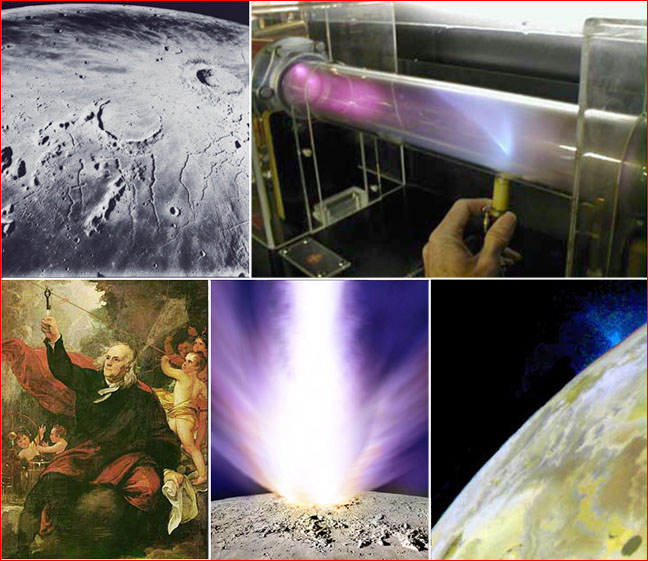
home •
about •
essential guide •
picture of the day •
thunderblogs •
news •
multimedia •
predictions •
products •
get involved •
contact

Caption: Upper Left: Complex of giant lunar rilles or trenches.
Right: Laboratory electron beam showing deflection by magnet.
Lower Left: painting by Benjamin West,"Benjamin Franklin Drawing
Electricity from the Sky".
Center: Artist illustration of electric discharge vortex on lunar
surface.
Right: "volcano" (electric discharge) on the Jovian moon Io.
pic of the day
archive
subject index
abstract
archive
Links:
Society for
Interdisciplinary
Studies
May 04, 2005
The
Electric Universe: Part II
Discharges and Scars
Throughout the twentieth century, astronomers relied upon gravitational mechanics and the kinetics of gases to explain things observed in the heavens. But this vision of the universe is increasingly at odds with new data returned by better telescopes and enhanced technologies.
Laboratory experiments with electric currents in plasma show that the currents can appear in three modes—dark, glow and arc—depending on the voltage and charge density. In a laboratory gas-discharge tube (pictured above), voltage and charge density vary non-linearly between the electrodes and produce segments that are alternately dark and glowing. The arc mode, which has a very high charge density, is used industrially for precision machining.
The degree of current filamentation depends on the density of the medium through which the current passes. For similar currents, one passing through a thin atmosphere will tend to produce a single columnar or tubular channel that spins around its axis. In the glow mode, this channel looks like a tornado of fire. We can see examples of this in the penumbraof a sunspot. The solar discharge is quenched in the umbra (the dark center) of a sunspot, giving us a side view of the “electric vortices” whose tops make up the “granular” appearance of the photosphere. In the dark mode, these “electric vortices” can become visible when the strong electric field pulls air, water or dust into their rotation, producing dust devils, waterspouts, and tornadoes.
A current passing through a thick atmosphere will tend to branch into a web of filaments. Some of these filaments will form concentric circles around the primary axis. Others will stretch radially away. In combination, they produce arrays that resemble a spider’s web and are therefore termed “arachnoids”. Such features are particularly common around the equator of the planet Venus, suggesting intense electrical activity in the past.
When a circuit passes through a solid body, the current will erode material from or deposit material on the surface where the arc touches down. It is essential therefore that planetary scientists be willing to consider the evidence of electrical surface erosion, which leaves distinctive scarring patterns: The pits or craters left by electric arcs are usually circular because the electric forces constrain the arc to strike at a right angle to the surface. Because the arc is composed of two (or more) filaments rotating around the axis, material is removed as with a drill bit, leaving steep sides and a “pinched up” rim of debris. If the filaments are sufficiently separated, they may leave a nipple of material in the center, as is seen in lunar craters that have central peaks. Material in the bottom of the crater, as also the material removed, will be electrically heated, possibly burned, and considerably melted.
If the surface is an anode (positively charged in the exchange), the arc will tend to stick in one place. This results in increased melting, and the electrical forces within the field of the arc may lift the surface to form a “blister,” called a fulgamite. There will still be a crater—or several overlapping craters—at the top. For example, a lightning strike will often raise a fulgamite on the metal cap of a lightning arrestor. At a larger scale, fulgamites appear as “domes” on Venus and as pedestal craters on Mars. Even larger scale examples are the Martian Olympus Mons and the so-called “volcanoes” on the Tharsis Rise.
If the surface is a cathode (negatively charged), the arc will tend to move across the surface. After striking, usually at a high point, and eroding a crater, the arc may jump to a new high point—the rim of the new crater is a most likely target. The abundance of small craters centered on the rims of larger ones testifies to this predictable behavior. As the arc travels, it may erode a series of craters in a line, appearing as a chain of craters. If the craters in these chains overlap, the effect is a steep-sided trench with scalloped edges. The arc may erode a trench for a distance and then jump some distance away before eroding another trench. These “dashed line” trenches will usually have circular ends and constant widths. All of these patterns occur in great abundance on the surface of Mars, a point we intend to fully demonstrate in coming Pictures of the Day.
A current running under the surface may heat the rock suddenly enough to cause a line explosion: The shock wave will blow out material to each side, producing levees, and the electrical erosion from the arc will leave a smaller, more sinuous trench in the bottom of the shock-generated trench. This form was first noticed on the Moon as the lunar rilles, but the pattern is also repeated across the surface of the Jovian moon Europa.
Advocates of the electrical discharge and electrical scarring hypothesis emphasize its greater unity and coherence over a broader range of data. The theory is empirically grounded, testable under laboratory conditions, and directly applicable at all scales of observations, from the microscopic pitting of tektites and concretions to solar vortices and the knotted polar jets of stars and galaxies.
EXECUTIVE EDITORS:
David Talbott, Wallace Thornhill
MANAGING EDITOR: Amy Acheson
CONTRIBUTING EDITORS: Mel Acheson, Michael Armstrong, Dwardu Cardona,
Ev Cochrane, C.J. Ransom, Don Scott, Rens van der Sluijs, Ian Tresman
WEBMASTER: Michael Armstrong
Copyright 2005: thunderbolts.info